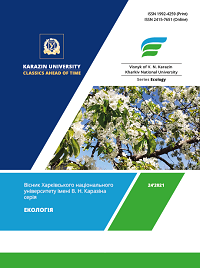Epizootic Situation on Honey Bees (Apis Mellifera) Varoosis in Selected Areas Within Chernivtsi Region (Ukraine)
Abstract
The material was collected during the summer period (June – August) of 2020 from 203 bee colonies of 80 private apiaries within four administrative districts in Chernivtsi region. We found that the share of colonies with infested worker honey bees was 34.80 ± 14.97 % and with infested sealed brood 38.98 ± 9.51 % of the studied colonies. The studied areas were characterized by different ratios of degrees of extensiveness of Varroa infestation of worker honey bees. The total share of the colonies without mites or with a low degree of extensiveness of varroosis invasion was the highest in all four districts. Two percent of the tested colonies from Khotyn and Storozhynets districts were characterized by a medium degree of damage and only 2.35 % of the colonies of Khotyn district had a high degree of extensiveness of Varroa invasion. According to the results of the analysis of the brood, 1.23 % of the surveyed colonies in Khotyn district were damaged to a high degree, and 2 % of the tested colonies in Storozhynets district to the extremely high degree.
The results indicate the need to perform annual monitoring of the epizootic situation on varroosis during summer period for the early detection of Varroa mites and improving methods for varroosis prevention and treatment.
Downloads
Published
Issue
Section
License
Copyright (c) 2021 Тимчук К. Ю., Баглей О. В., Жук А. В., Филипчук Т. В., Федоряк М. М.,

This work is licensed under a Creative Commons Attribution 4.0 International License.
Authors reserve the right of attribution for the submitted manuscript, while transferring to the Journal the right to publish the article under the Creative Commons Attribution License. This license allows free distribution of the published work under the condition of proper attribution of the original authors and the initial publication source (i.e. the Journal)Authors have the right to enter into separate agreements for additional non-exclusive distribution of the work in the form it was published in the Journal (such as publishing the article on the institutional website or as a part of a monograph), provided the original publication in this Journal is properly referenced
The Journal allows and encourages online publication of the manuscripts (such as on personal web pages), even when such a manuscript is still under editorial consideration, since it allows for a productive scientific discussion and better citation dynamics (see The Effect of Open Access).

